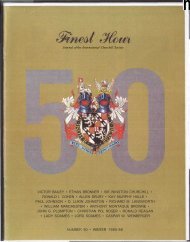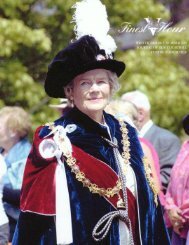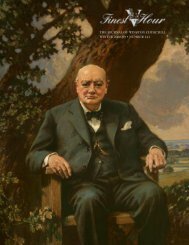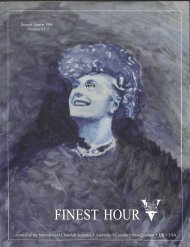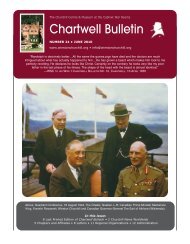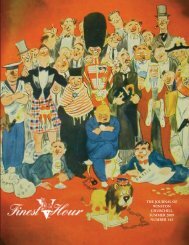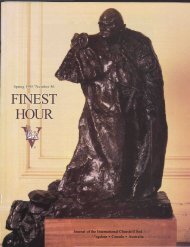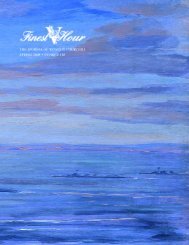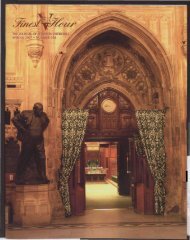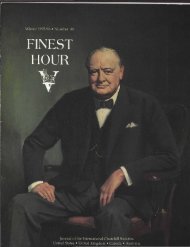You also want an ePaper? Increase the reach of your titles
YUMPU automatically turns print PDFs into web optimized ePapers that Google loves.
Small Craft, Short Visits<br />
On at least three occasions, <strong>Churchill</strong> spent short<br />
periods on destroyers. Six days after the Normandy landings,<br />
he took a one-day outing to view the invasion beaches<br />
aboard HMS Kelvin which, to his delight, fired on German<br />
shore positions while he was aboard. The ship sailed from<br />
and returned to Portsmouth. Ten days later he boarded the<br />
destroyer HMS Enterprise off Arromanches, France to<br />
witness the invasion’s progress. And in August 1944, he was<br />
aboard HMS Kimberley to observe troops going ashore on<br />
the French Riviera.<br />
He briefly traveled on two light cruisers: Early in<br />
1945, traveling as “Colonel Kent” en route to Yalta, he<br />
spent two days aboard HMS Orion in Malta’s French<br />
Creek. He used the admiral’s cabin to sleep and shake a<br />
fever, and to meet with aides. 20 Homeward bound after<br />
Yalta, he rested for a few days aboard the cruiser HMS<br />
Aurora in the Egyptian port of Alexandria.<br />
<strong>Churchill</strong> made numerous short hops to visit troops<br />
on the Continent on C-47 Dakota twin-engine transports,<br />
usually flown by the RAF. Some 10,000 were manufactured;<br />
this military version of the ubiquitous DC-3 airliner saw<br />
service in every theater. Seating twenty-one in airline<br />
service, but twenty-eight or more in military guise, the C-<br />
47 carried anything and everyone. Americans dubbed it<br />
“Skytrain” for its flexible capacity. The Dakota was the<br />
largest of the twin-engine aircraft which carried WSC.<br />
In addition to the Flamingo for his French flights in<br />
mid-1940, <strong>Churchill</strong> also flew on Lockheed Lodestars.<br />
Based on the civilian Model 18 airliner, the military<br />
Lodestar first flew in mid-1941 and saw extensive use with<br />
multiple services and countries in most theaters. Supplied to<br />
the RAF under Lend-Lease, Lodestars served as VIP transports<br />
operated by RAF No 173 squadron in North Africa<br />
beginning in mid-1942. 21 And <strong>Churchill</strong> flew aboard a U.S.<br />
Navy Lodestar from Norfolk to Washington on one of his<br />
American trips.<br />
<strong>Churchill</strong>’s exhaustive wartime travel and vast array of<br />
conveyances demonstrate his determination to overcome<br />
time and distance, even in the face of discomfort and potential<br />
danger. The logistics in arranging these trips were<br />
complex; many were pioneering flights over huge distances.<br />
But he was a great believer in personal diplomacy, and his<br />
methods helped him cement the personal relationships he<br />
saw as so valuable to international relations. ,<br />
Endnotes<br />
1. For the chronology, see Lavery, Pawle and (though less detailed)<br />
Celia Sandys, Chasing <strong>Churchill</strong>: Travels with <strong>Winston</strong> <strong>Churchill</strong> (London:<br />
HarperCollins, New York: Carroll & Graf, 2003). As for the substance of<br />
these trips, there are shelves of books, including <strong>Churchill</strong>’s own sixvolume<br />
war memoirs.<br />
2. The best and most complete account of most (though not all)<br />
of these journeys is in Brian Lavery, <strong>Churchill</strong> Goes to War: <strong>Winston</strong>’s<br />
Wartime Journeys (Annapolis: Naval Institute Press, 2007). Lavery’s maps,<br />
diagrams and photos are especially helpful.<br />
3. The first detailed account of the arrangements that lay behind<br />
these many trips is in Gerald Pawle, The War and Colonel Warden<br />
(London: Harrap, 1963) whose title is one of <strong>Churchill</strong>’s travel code<br />
names. Pawle’s book is based on the recollections of Royal Navy<br />
Commander “Tommy” Thompson, who closely planned many foreign<br />
trips and was present for most.<br />
4. For a summary, see Christopher Sterling, “<strong>Churchill</strong> Afloat:<br />
Liners and the Man,” Finest Hour 121 (Winter 2003-4),16-22.<br />
5. Christopher Sterling, “<strong>Churchill</strong> and Air Travel: Ahead of His<br />
Time,” Finest Hour 118 (Spring 2003), 24-29.<br />
6. Email communication, Robert Duck to Richard Langworth, 9<br />
December 2007.<br />
7. Three of the craft, huge for their time, had been purchased for a<br />
million dollars each from Pan American Airways, which retained nine<br />
others for its Pacific and Atlantic routes. The purchase was made about<br />
the time <strong>Churchill</strong> was making his aerial round-trips to France.<br />
8. Vanderkloot’s adventures flying <strong>Churchill</strong> (he died in 2000 at<br />
age 85) are related in the accompanying article by his son, and in Bruce<br />
West, The Man Who Flew <strong>Churchill</strong> (Toronto: McGraw-Hill Ryerson,<br />
1975). Unfortunately, the book is filled with fictional “conversations”<br />
and suppositions of what people were thinking, and it lacks an index. See<br />
also Verna Gates, “<strong>Churchill</strong> Was His Copilot,” Today’s Officer (October<br />
2004), available at http:// www.moaa.org/todaysofficer. Vanderkloot’s son<br />
recently addressed our Georgia affiliate.<br />
9. Commando was not always black. One of the few photos of the<br />
complete aircraft shows her in natural metallic finish, but not the olive<br />
drab then so common. See Peter Masefield and Bill Gunston, Flight Path<br />
(Shrewsbury, England: Airlife, 2002), 131. Masefield claims <strong>Churchill</strong><br />
flew this trip on a different though similar transport, the Marco Polo, but<br />
no other source—including <strong>Churchill</strong>’s own memoirs—agrees.<br />
10. T. M. Gibson and M. H. Harrison, Into Thin Air: A History of<br />
Aviation Medicine in the RAF (London: Robert Hale, 1984), 80.<br />
11. Jerrard Tickell, Ascalon: The Story of Sir <strong>Winston</strong> <strong>Churchill</strong>’s<br />
War-Time Flights 1943 to 1945 (London: Hodder & Stoughton, 1954),<br />
79. The subtitle is anachronistic, since <strong>Churchill</strong> was knighted in 1953,<br />
not during World War II. The book is now difficult to find.<br />
12. Donald Hannah, The Avro York (Leatherhead, England: Profile<br />
Publication No. 168, no date), 4. Lavery is mistaken when he says this<br />
airplane was lost over the Atlantic in 1945 (371). In reality she served for<br />
a decade after flying <strong>Churchill</strong>. The lost aircraft was Commando.<br />
13. Arthur Pearcy, “Douglas DC-4,” Chapter 8 of Douglas<br />
Propliners DC-1 to DC-7 (Shrewsbury, England: Airlife, 1995), 105-16.<br />
Douglas began designing a larger follow-on airliner to its world-beating<br />
DC-3 in the late 1930s. First flown in 1938, the DC-4E (for experimental)<br />
was deemed too large by airline managers of the time, and the<br />
prototype was sold to Japan. Reworked to a trimmer size, the new aircraft<br />
first flew in early 1942. Army and Navy demand for a larger transport<br />
meant that none would enter their intended airline service until after the<br />
war. Instead, designating them C-54 “for the duration,” Douglas began<br />
turning out bare bones four-engine transport aircraft.<br />
14. Several sources quote this line. See, for example, Lavery, 301<br />
(and the previous page, which includes a diagram of the special<br />
Skymaster’s layout).<br />
15. Pearcy, 108.<br />
16. This journey was <strong>Churchill</strong>’s first trip aboard a ship he would<br />
sail on often in later years. He published an article about the Queen Mary<br />
at the time of her maiden voyage, in The Strand Magazine, May 1936. A<br />
reprint is in Finest Hour 121 (Winter 2003-04), 23-28.<br />
17. John Colville, The Fringes of Power: Downing Street Diaries<br />
1939-1955 (New York: Norton, 1985), 424.<br />
18. A good contemporary account of the trip is in H. V. Morton,<br />
Atlantic Meeting (London: Methuen, 1943).<br />
19. Tickell, 69-70.<br />
20. Douglas Austin, <strong>Churchill</strong> and Malta: A Special Relationship<br />
(Stroud, England: Spellmount, 2006), 161.<br />
21. David J. March, ed., British Warplanes of World War II<br />
(London: Amber Books, 1998), 171.<br />
FINEST HOUR 148 / 15



